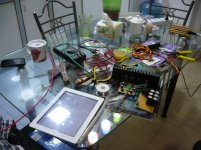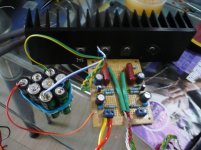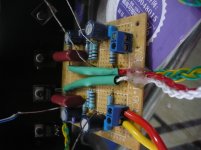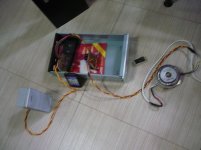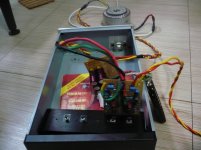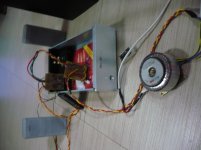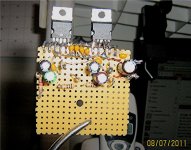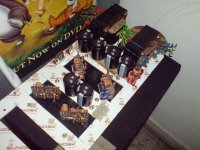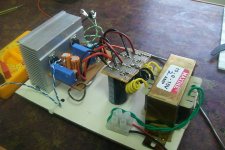Nice enclosures apoopoo999. How are they made? I assume the front is custom laser cut, but what about the sides? Are they some sort of box section aluminium?
The sides are made from 3" x 3/4" thick aluminum made by 8020
8020 T Slot Aluminum Extrusion 15 S 3034 L x 48 N - eBay (item 370155124158 end time Aug-24-11 08:18:41 PDT)
Who tells us the PSU is not bigger than the amplifier?
Here's an excellent example showing that the PSU must not be skimped.
Totally agree!
Great design as well. I like it, well done!
LM1875 btl
this is my first amp project, it was ugly, full of frustration and pain, of course gain at last, anyway share with you guys.
this is my first amp project, it was ugly, full of frustration and pain, of course gain at last, anyway share with you guys.
Attachments
Hacked It!!!
For the second time in about 30 years, working with the LM383 / TDA2003 line of "car radio" amplifier chip amps, I came up with one that was stable, no oscillation!!! The first time I had a stable amp and did not know why and also didn't document that circuit, in the early 90's. Raymond Haigh's explanations and circuit board art gave me all the insight I needed to identify and correct all of my grounding issues. I ended up using 3 grounding systems in my amp, one for the DC power and speaker RC network grounds, one for the feedback components grounding, and one for the input ground on each chip, when I translated to perf-board!
Raymond Haigh on chip amps: http://www.transkommunikation.ch/da.../audio_circuits/Diverse%20NF-Verst%E4rker.pdf
2 X TDA2003 amp, about 10 Watts RMS, onset of clipping
into 4 ohms, 13.8 VDC powered.
For the second time in about 30 years, working with the LM383 / TDA2003 line of "car radio" amplifier chip amps, I came up with one that was stable, no oscillation!!! The first time I had a stable amp and did not know why and also didn't document that circuit, in the early 90's. Raymond Haigh's explanations and circuit board art gave me all the insight I needed to identify and correct all of my grounding issues. I ended up using 3 grounding systems in my amp, one for the DC power and speaker RC network grounds, one for the feedback components grounding, and one for the input ground on each chip, when I translated to perf-board!
Raymond Haigh on chip amps: http://www.transkommunikation.ch/da.../audio_circuits/Diverse%20NF-Verst%E4rker.pdf
2 X TDA2003 amp, about 10 Watts RMS, onset of clipping
into 4 ohms, 13.8 VDC powered.
Attachments
Last edited:
Now They Tell Me!!!
Ha! I went to the datasheet for the LM1875 and it also gives all that great information on grounding and stability concerns. Too bad NS didn't include the info in the LM383 datasheet! It would have been great to know that stuff 30 years ago!!!
Congratulations Edgar!
I used to destroy speakers using TDAslots of fun around 18years ago... when I was 16... then I discovered LM1875 and fell inlove with it...
Great PDF as well... thank you for sharing.
Ha! I went to the datasheet for the LM1875 and it also gives all that great information on grounding and stability concerns. Too bad NS didn't include the info in the LM383 datasheet! It would have been great to know that stuff 30 years ago!!!

My first LM1875 for my PC system
More pics at - https://picasaweb.google.com/103346623669691743811/LM1875#
And my LM4780 based 5.1 setup in progress...
More pics -> https://picasaweb.google.com/103346623669691743811/Sub#
Will update the complete build shortly.
More pics at - https://picasaweb.google.com/103346623669691743811/LM1875#
And my LM4780 based 5.1 setup in progress...
More pics -> https://picasaweb.google.com/103346623669691743811/Sub#
Will update the complete build shortly.
Attachments
Last edited:
My first LM1875 for my PC system
An externally hosted image should be here but it was not working when we last tested it.

A PC heat sink without a fan is less efficient than just a 8"x4" square of heavy gauge aluminum plate.
The fins are too dense to allow for efficient convection.
The sink should also be turned 90 degrees so that the fins are vertical to have any hope of convection...
A PC heat sink without a fan is less efficient than just a 8"x4" square of heavy gauge aluminum plate.
The fins are too dense to allow for efficient convection.
The sink should also be turned 90 degrees so that the fins are vertical to have any hope of convection...
I didn't know that.. thanks!
A PC heat sink without a fan is less efficient than just a 8"x4" square of heavy gauge aluminum plate.
The fins are too dense to allow for efficient convection.
The sink should also be turned 90 degrees so that the fins are vertical to have any hope of convection...
Ya definatly, i'll be used cooling fan also once installed in PC cabinet
The heatsink is meant for force cooling.
(I don't want to hijack the picture thread, but my question is hardly worth starting a new thread for.)
How much heatsinking does LM3886 actually need? I've just received a pair of LM3886 kits from Analog Metric Limited - DIY Audio Kit & am thinking about enclosures for them. Do they actually need heatsinks, or can I just bolt them to a suitably thick metal enclosure? The amp in this auction simply bolts them to a (thin) steel enclosure ;
NE5532 + LM3886 Audio Amplifier Home Audio AMP 68W+68W | eBay
How much heatsinking does LM3886 actually need? I've just received a pair of LM3886 kits from Analog Metric Limited - DIY Audio Kit & am thinking about enclosures for them. Do they actually need heatsinks, or can I just bolt them to a suitably thick metal enclosure? The amp in this auction simply bolts them to a (thin) steel enclosure ;
NE5532 + LM3886 Audio Amplifier Home Audio AMP 68W+68W | eBay
(I don't want to hijack the picture thread, but my question is hardly worth starting a new thread for.)
How much heatsinking does LM3886 actually need? I've just received a pair of LM3886 kits from Analog Metric Limited - DIY Audio Kit & am thinking about enclosures for them. Do they actually need heatsinks, or can I just bolt them to a suitably thick metal enclosure? The amp in this auction simply bolts them to a (thin) steel enclosure ;
NE5532 + LM3886 Audio Amplifier Home Audio AMP 68W+68W | eBay
Do a little searching and you will be rewarded.
The amp in this auction simply bolts them to a (thin) steel enclosure ;
Steel is an extremely poor conductor of heat so the poor chips would have virtually no heat-sink at all!
Frank
I've got no problems with sourcing heatsinks, I'm just trying to ascertain how much heatsinking is actually required & how much I see in many of the builds is more just for show. I'm trying to keep my builds as simple as possible, so if I can get away with bolting the chips to a thicker enclosure rather than working heatsinks into the design, all the better!Scrap yards are a good source of heatsinks and enclosures, take a pic of one with you. They'll sell them to you at weight value, they might add a bit though
How about a fairly thick aluminium enclosure? Something like Hammond's 1550Z Series? Hammond Mfg. - Watertight - Thick Wall - Diecast Aluminum (1550Z Series)frank1 said:Steel is an extremely poor conductor of heat so the poor chips would have virtually no heat-sink at all!
(I don't want to hijack the picture thread, but my question is hardly worth starting a new thread for.)
How much heatsinking does LM3886 actually need? I've just received a pair of LM3886 kits from Analog Metric Limited - DIY Audio Kit & am thinking about enclosures for them. Do they actually need heatsinks, or can I just bolt them to a suitably thick metal enclosure? The amp in this auction simply bolts them to a (thin) steel enclosure ;
NE5532 + LM3886 Audio Amplifier Home Audio AMP 68W+68W | eBay
Hardware stores usually have aluminum bars for sale. If you get a piece taller that the LM3886 chip and 4 times as wide, mount it inbetween the chip and the chassis, it will act as a heat "spreader" and move more heat to a wider area of a metal enclosure.
- Home
- Amplifiers
- Chip Amps
- Chip Amp Photo Gallery
